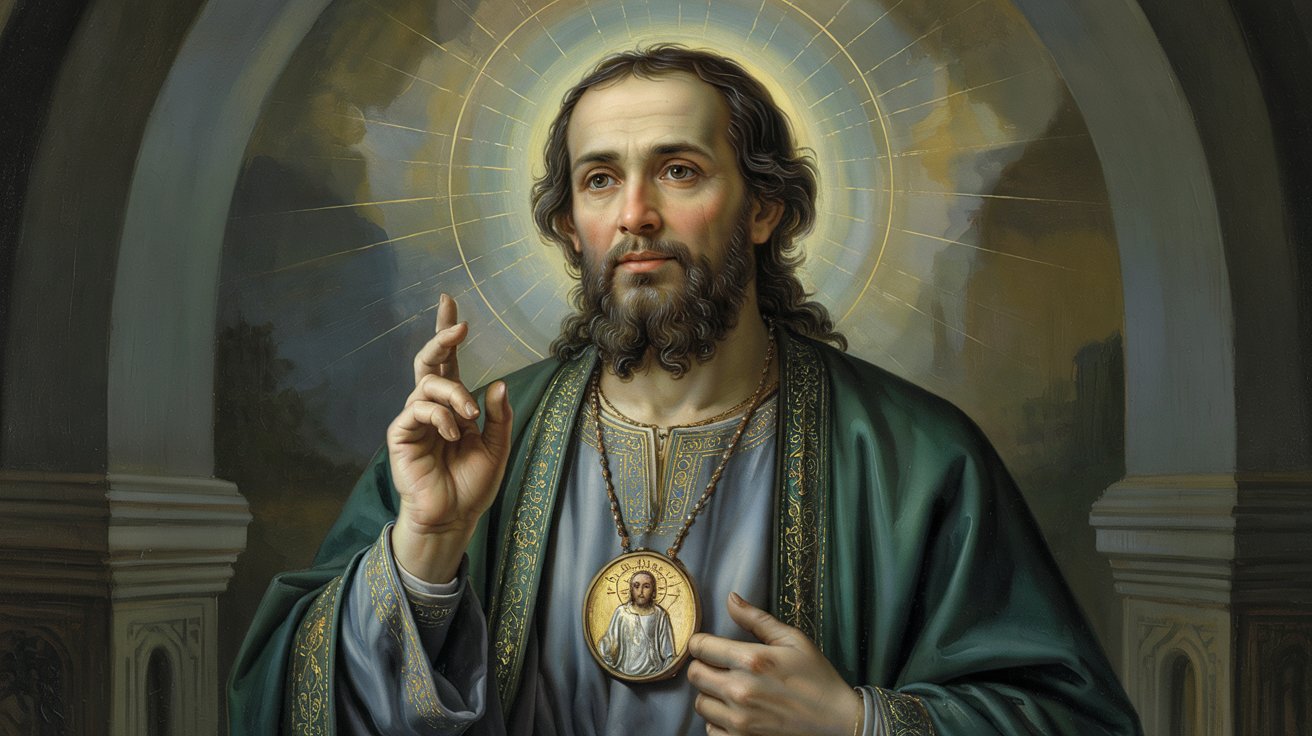A Unique Exploration of His Life, Epistle, and Enduring Legacy
Introduction: Beyond the Prayer Card
The Paradox of St. Jude
Among the Twelve Apostles, St. Jude Thaddeus stands out as one of the most invoked saints in popular Catholic devotion—especially as the patron of impossible or hopeless causes. Yet historically, he is among the most obscure figures. One can walk into many churches around the globe and see novena candles and prayer cards bearing his image, but records of his life remain fragmentary at best.
Who Is St. Jude?
St. Jude is traditionally identified as:
- One of the Twelve Apostles of Jesus (listed under variations of Jude/Judas/Thaddeus/Lebbaeus).
- A relative (or “brother”) of Jesus, according to some traditions.
- The author of the brief but potent Epistle of Jude in the New Testament.
- A martyr who, according to various accounts, met a violent end while preaching the Gospel.
Despite these credentials, confusion with Judas Iscariot lingered in many Christian minds over the centuries, and that blurred identity may have ironically contributed to Jude’s later association with difficult or “last resort” petitions.
The Goal & Unique Approach
This article goes beyond repeating the popular notion of St. Jude as the saint of lost causes. It aims to:
- Reconstruct Jude’s likely world and ministry in the dynamic context of the 1st-century Middle East.
- Examine his specific written contribution—the Epistle of Jude—to understand the real challenges facing early Christians.
- Trace how and why he became the patron of seemingly hopeless situations, particularly in the West.
- Explore his persistent pairing with Simon the Zealot and how that partnership became entrenched in later tradition.
Thesis Statement
By piecing together scriptural references, historical context, a close reading of his Epistle, and the centuries-long evolution of devotional tradition, we can see Jude Thaddeus not merely as a “miracle-working saint” for desperate cases, but as a key figure who navigated the turbulent birth of Christianity while exhorting fellow believers to “contend for the faith.”
Forging an Identity: Names, Kinship, and Distinction
The Puzzle of Names
Scripture and early Christian writings refer to this Apostle by multiple names: “Jude,” “Judas (not Iscariot),” “Thaddeus,” and “Lebbaeus.” These variations sometimes appear in the same Gospel tradition (e.g., Matthew 10:3 in the KJV calls him “Lebbaeus, whose surname was Thaddaeus”). Scholars propose several reasons:
- Disambiguation from Judas Iscariot: To avoid any hint of confusion with the betrayer.
- Regional Variations: Different communities had differing linguistic preferences (Aramaic vs. Greek, for example).
- Nicknames: Names like Thaddeus (sometimes interpreted as “courageous heart”) or Lebbaeus could have been affectionate epithets.
Table 1: Apostle List Variations & Jude’s Identification
| Gospel/Book | Name(s) Used | Position | Notes |
|---|---|---|---|
| Matthew 10:2–4 | “Lebbaeus, whose surname was Thaddaeus” | 10th | KJV lists him distinctly from Judas Iscariot, emphasizing the surname form. |
| Mark 3:16–19 | “Thaddaeus” | Near the end | Listed just before Simon the Cananaean (the Zealot). |
| Luke 6:12–16 | “Judas the son of James” | 11th | Luke omits the Thaddeus name. |
| Acts 1:13 | “Judas the son of James” | 10th | Post-Resurrection listing of the Eleven, excluding Iscariot. |
The “Brother of the Lord”?
In the Gospels of Matthew (13:55) and Mark (6:3), we see reference to Jesus’ “brethren,” naming James, Joses, Simon, and Judas. Tradition has often identified this “Judas” as the same Jude who became an Apostle. The Greek word adelphos can mean a literal brother, half-brother, step-brother, or even a close relative like a cousin. Interpretations vary:
- Catholic & Orthodox View: Typically regard them as cousins or step-siblings (if Joseph was a widower with children from a previous marriage).
- Some Protestant Views: Tend to see them as younger siblings of Jesus, children of Mary and Joseph.
Whatever the precise relationship, it suggests Jude had a familial link to Jesus, giving him a distinctive perspective and closeness among the Apostles.
Clearing the Confusion
Any discussion of Jude must differentiate him from Judas Iscariot, who betrayed Jesus. This confusion helped make Jude an overlooked or “forgotten” Apostle for centuries—some believers felt uneasy invoking any saint named Judas. Ironically, over time, he became known as the saint to turn to when all else failed, precisely because so few would pray to “Judas” unless desperate.
The Apostolic Mission: Reconstructing Jude’s World (c. 30 AD – c. 65 AD?)
Called by Christ
Like most of the Twelve, Jude was likely from Galilee, a region shaped by a mix of Jewish faith, Hellenistic cultural influence, and Roman political control. In John 14:22, Jude asks Jesus: “Lord, how is it that you will manifest yourself to us, and not to the world?” His question underscores a concern common among the Apostles—how the Messiah would be revealed, especially under Roman rule and Jewish expectations of a political deliverer.
Post-Pentecost Evangelization: Following the Fragments
After Pentecost (Acts 2), tradition holds that each Apostle embarked on missionary journeys. For Jude, various apocryphal sources and early Church traditions place him in:
- Judea & Samaria – The immediate regions around Jerusalem.
- Mesopotamia (Edessa) – A culturally diverse zone under the Parthian Empire. Legends connect him with King Abgar of Edessa, although these stories are hard to verify historically.
- Persia – Dominated by Zoroastrianism, a challenging mission field for early Christians.
- Armenia – Credited in later tradition as an early Christian stronghold, sometimes linked with multiple Apostles (including Bartholomew).
- Libya – A less common tradition suggests some evangelization here.
Timeline 1: Speculative Chronology of St. Jude’s Life & Ministry
- Estimated Birth Year: Early 1st century (around 5–15 AD?).
- ~30 AD: Called to be an Apostle.
- ~33 AD: Witnessed the Resurrection and experienced Pentecost.
- 33–40s AD: Likely stayed around Judea and neighboring regions.
- 40s–60s AD: Missions further afield in Mesopotamia/Persia.
- Mid-60s AD: Composition of the Epistle of Jude (traditionally).
- ~65–70 AD: Martyred according to most legends.
The Realities of 1st Century Mission
Travel in the 1st century Mediterranean and Near East was difficult, especially when venturing beyond Roman-controlled regions. Evangelizing in Parthian or Persian domains added cultural, linguistic, and political obstacles. Missionaries had to contend with:
- Geopolitical Instability: The longstanding Roman-Parthian rivalry shaped border tensions.
- Cultural Resistance: Local religions like Zoroastrianism and entrenched pagan practices often opposed Christian missionaries.
- Language Barriers: Aramaic and Greek might not always suffice in remote areas.
- Danger of Persecution: Both Roman and non-Roman authorities could view new religious movements with suspicion.
Table 2: Context of St. Jude’s Traditional Mission Fields
| Region | Ruling Power (c. 40–65 AD) | Dominant Religions | Challenges for Christian Mission |
|---|---|---|---|
| Mesopotamia | Parthian Empire | Mixed Judaism, local pagan cults | Parthian–Roman tensions, cultural diversity |
| Persia | Parthian overlordship | Zoroastrianism (state-backed) | Hostility toward new faiths, court intrigues |
| Armenia | Client kingdoms | Early pagan cults, some Judaism | Political shifts, mountainous terrain, local gods |
| Libya | Roman Africa (in part) | Hellenistic/pagan traditions | Local syncretism, few Jewish communities |
The Epistle of Jude: A Call to Contend
Authorship, Date, and Audience
The Epistle of Jude is one of the shortest books in the New Testament. Traditionally, it’s ascribed to “Jude, a servant of Jesus Christ, and brother of James” (Jude 1:1). Critical scholarship varies on its exact date, but many place it between the 50s and 60s AD—before the destruction of the Jerusalem Temple in 70 AD. The original audience seems to be Jewish Christians who were wrestling with false teachers and moral laxity within their communities.
Deconstructing the Warnings: Specific Threats in the Early Church
Jude’s letter directly confronts a group (or groups) who were distorting the Gospel. Key issues include:
- Antinomianism/Libertinism – Twisting divine grace into an excuse for immoral living (v. 4).
- Denial of Christ’s Authority – Rejecting established apostolic teaching and the lordship of Jesus (vv. 4, 8).
- Divisiveness & Worldliness – Accusations of grumbling, malcontent attitudes, stirring up factions (vv. 16, 19).
- Disrespect for Angelic Authority – Dismissing or mishandling spiritual realities (vv. 8–10).
These may reflect early forms of what would later be called “Gnostic” tendencies—elevating secret knowledge while despising moral or ecclesial boundaries.
Literary Style and Influences
Despite its brevity, Jude’s Epistle is distinctive for its vivid imagery and references to Jewish apocryphal texts. He cites examples from the Old Testament (Cain, Balaam, Korah) and alludes to non-canonical works (Book of Enoch, possibly the Assumption of Moses). This reveals a thought-world steeped in broader Jewish tradition, even as it addresses nascent Christian communities.
Core Message
Jude famously exhorts believers to “contend earnestly for the faith which was once for all delivered to the saints” (v. 3). He mixes strong warnings with pastoral calls for mercy: “Have mercy on some who are wavering; save others by snatching them out of the fire” (vv. 22–23). The letter concludes with a stirring doxology that attributes all power and glory to God (vv. 24–25).
Table 3: Key Themes & Warnings in the Epistle of Jude
| Verse(s) | Theme / Warning | 1st Century Context | Later Church Echoes |
|---|---|---|---|
| 3–4 | Contend for the faith; false teachers | Early infiltration of antinomian ideas | Repeated pattern of heresies prompting church councils |
| 8–10 | Rejecting authority, angelic realms | Possible proto-Gnostic beliefs or extreme libertinism | Later conflicts over angelology, Gnostic sects |
| 11 | OT parallels: Cain, Balaam, Korah | Drawing on Jewish moral lessons familiar to audience | Persevered in Christian moral teaching and warnings |
| 22–23 | Mercy vs. fiery rescue | Encouraging nuanced pastoral care in crises of faith | Ongoing tension between church discipline & mercy |
| 24–25 | Doxology | Confession of divine sovereignty and hope | Central to Christian worship and benedictions |
Martyrdom and the Simon Partnership
The Journey’s End
Most traditions agree Jude suffered martyrdom, though exact details vary:
- Location: Persia is a common Western tradition; others place it in Beirut or Armenia.
- Manner of Death: Some accounts mention a club, an axe, or a halberd—hence the frequent depiction of Jude with these instruments in art.
The Simon & Jude Connection
In Western Christianity, St. Jude is almost always coupled with Simon the Zealot:
- Feast Day: October 28th in the Roman Catholic calendar.
- Golden Legend (13th century): Popularized their joint martyrdom in Persia, forging a long-lasting narrative link.
Explanations for their pairing range from shared mission fields in Eastern territories to the need for liturgical consolidation of feast days. Eastern traditions, however, sometimes give them separate paths.
Development of Martyrdom Narratives
Detailed stories of the Apostles’ final years and deaths solidified in the centuries after Constantine (4th century) and found their most popular medieval expression in works like the Golden Legend. These accounts, while not always historically verifiable, shaped devotional life and the hagiographical imagination for generations.
Timeline 2: Evolution of Jude’s Martyrdom Story & Simon Partnership
- Early Church (1st–3rd centuries): Brief notes on his missionary work and martyrdom, but few details.
- Post-Constantine (4th–5th centuries): Gradual collection of tradition in ecclesiastical writings.
- Middle Ages (especially 13th century): Golden Legend cements their joint mission and martyrdom in the Western mind.
- Modern Era: Liturgical calendars and devotional texts continue to keep Simon & Jude together.
The Unfolding Legacy: From Apostle to Patron Saint
Early Veneration
The early Church recognized all the Apostles as foundational figures; Jude’s Epistle secured him a permanent voice in the Christian canon. Beyond that, veneration in the first few centuries was somewhat overshadowed by better-documented saints and martyrs (e.g., Peter, Paul).
The Rise of the “Impossible Causes” Patronage
Over the centuries, St. Jude accrued the reputation as the “Saint of Impossible Causes” or “Patron of Hopeless Cases.” Historically, this emerged more robustly in the Middle Ages and onward. Proposed reasons include:
- “Last Resort” Theory: Devotees were hesitant to pray to any “Judas,” so Jude became a final, desperate option.
- Epistle’s Urgency: Jude’s letter calls for steadfastness in crises, resonating with believers facing dire circumstances.
- Missionary Hardships: He allegedly evangelized perilous regions (Persia, Armenia), symbolizing a saint who overcame daunting odds.
- Mystical & Devotional Promoters: Saints like Bridget of Sweden or various mystics’ testimonies popularized devotion.
- Documented Miracles: Reported miracles credited to St. Jude devotions reinforced the belief that he intercedes powerfully for lost causes.
Iconography and Symbols
In sacred art, St. Jude often appears with distinctive attributes:
Table 4: St. Jude’s Iconography Explained
| Symbol | Meaning / Representation | Origin / Tradition |
|---|---|---|
| Medallion/Mandylion | Linked to the “Abgar legend” of Edessa and Christ’s image | Apocryphal story of Jude bearing the image of Christ to King Abgar |
| Flame above head | The Holy Spirit’s descent at Pentecost | Common to Apostles, emphasizes Jude’s Pentecostal empowerment |
| Club/Axe/Halberd | Instrument of martyrdom | Reflects tradition of his violent death |
| Book/Scroll | The Epistle of Jude | Stresses his role as a New Testament writer |
| Carpenter’s Rule | Possible nod to kinship with Jesus | Sometimes used, though less frequent in Western art |
Modern Devotion
Today, shrines dedicated to St. Jude exist around the world:
- Chicago, IL (U.S.): The National Shrine of St. Jude
- Baltimore, MD (U.S.): A major center of novena prayer
- Faversham (UK): The National Shrine of Saint Jude run by the Carmelite Order
Novenas to St. Jude are common in Catholic tradition, and devotion has even spread to other Christian denominations, highlighting his universal appeal as a saint of last hope.
Conclusion: The Enduring Relevance of St. Jude
St. Jude Thaddeus began as a relatively shadowy Apostle in biblical accounts—overshadowed in name by Judas Iscariot, overshadowed in records by more prominent figures like Peter and Paul. Yet his single-chapter Epistle pulses with a passionate call to defend authentic faith amidst confusion and error. Over the centuries, stories of his missionary labors, martyrdom, and powerful intercession for impossible causes took shape and spread across Christendom.
By exploring Jude’s historical context, examining his Epistle’s urgent warnings against false teachings, and tracing how his devotion developed—particularly through the Middle Ages—we see a man who served the fledgling Church in perilous times. His message to “contend earnestly for the faith” resonates across eras, speaking to believers facing crises of belief or simply enduring life’s harshest trials.
In a world that continues to grapple with spiritual, cultural, and existential uncertainties, St. Jude’s example offers both a steadfast commitment to truth and a beacon of hope. He stands as a bridge between the earliest Judeo-Christian milieu and the modern faithful who seek solace in seemingly hopeless situations. Whether invoked for miracles or studied for his fiery first-century Epistle, St. Jude remains a compelling figure—an Apostle who once questioned how Jesus would reveal Himself to the world, and who ultimately helped reveal that Good News in some of the world’s most challenging places. Through that unwavering dedication, his legacy endures as a source of faith in adversity and enduring hope for all who call upon his name.






